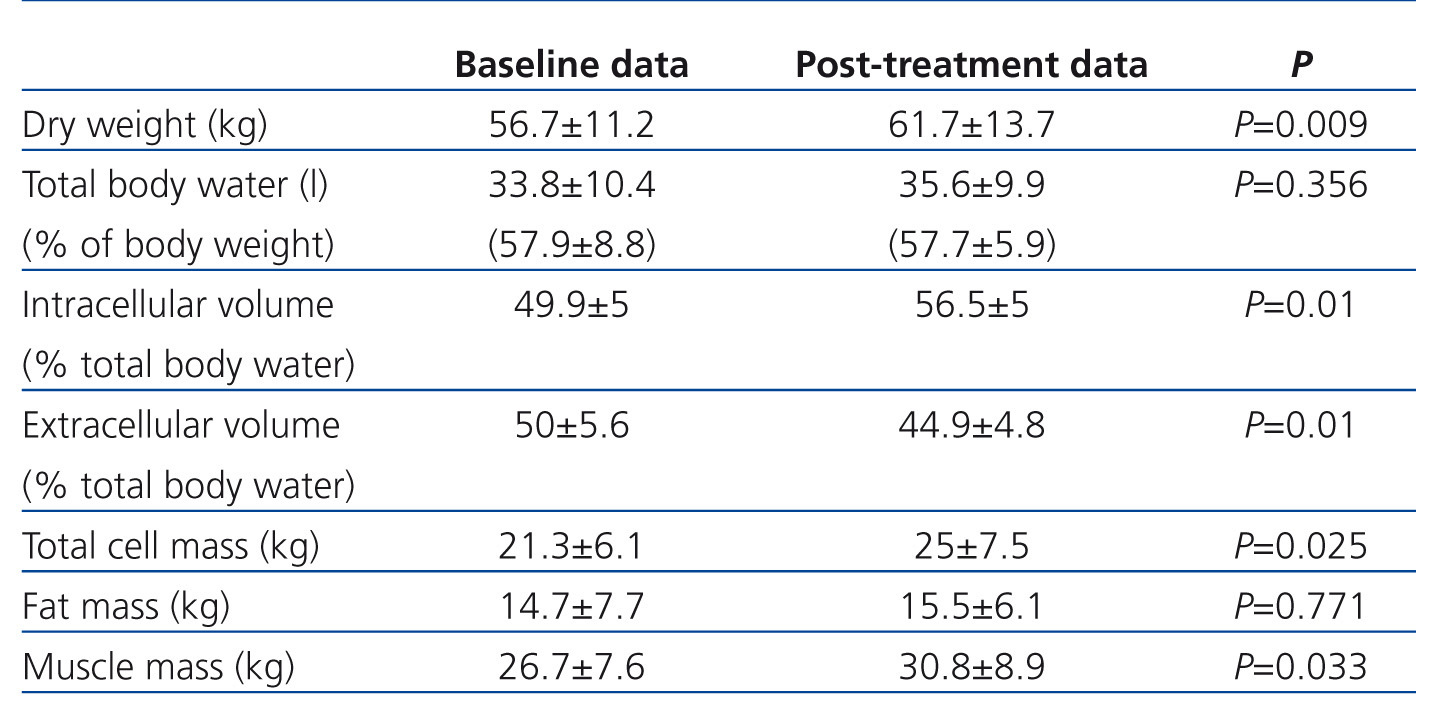To the Editor:
Megestrol acetate is an appetite stimulant used in the treatment of uraemic patients’ anorexia. When administered in appropriate doses, it achieves an increase in weight and the improvement of other nutritional parameters without significant side effects.1
The body compartment responsible for weight gain induced by megestrol acetate is a subject of controversy. Very few studies have examined this issue and the results are conflicting. While the work by Golebiewska et al. observed a tendency to retain hydrosaline,2 other authors observed increased fat mass3,4 and increased fat free mass.5
We had the opportunity to analyse body composition with electrical bioimpedance techniques in 9 patients who experienced significant weight gain after treatment with megestrol acetate.
Our patients are 4 males and 5 females, between 40 and 80 years of age. None had residual renal function and they were treated with three weekly sessions of haemodialysis. All received a daily dose of 160mg megestrol acetate.
The baseline electrical bioimpedance analysis was performed immediately before the start of treatment with megestrol acetate and it was repeated before withdrawal of the treatment when the patients were considered to have overcome a state of malnutrition and experienced a significant increase in weight. We used a single frequency bioimpedance model with the standard tetrapolar technique (EFG ElectroFluidGraph analyzer, Akern SRL, Florence, Italy). Bioimpedance studies were performed after the haemodialysis session, following a five minute rest period in the supine position, using a current of 300 microA a 50kHz.
The duration of treatment with megestrol acetate ranged between 2 and 12 months (6.5±3.8, mean ± standard deviation). The dose of dialysis did not change during this time period (Daurgidas unicompartmental Kt/V: baseline 1.48 end 1.50). After the treatment, patients experienced an increase in weight which varied between 2 and 9kg associated with an increase in the protein catabolic rate (1.25 compared with 0.97g/kg/day, P<.05) , albumin concentration (3.9 compared with 3.50g/dl, P<.05), serum creatinine (10.1 compared with 8.34mg/dl, P<.05) and urea (198 compared with 175mg/dl, P<.05), without there being variations in the concentration of phosphorus (4.9 compared with 4.8mg/dl) and the dialysis dose (Daurgidas spKt/V 1.47 compared with 1.49). Table 1 shows the body composition data provided by the bioimpedance analysis before and after treatment with megestrol acetate.
Treatment with megestrol acetate leads to a better distribution of total body water with increased intracellular water component. Increased intracellular water is consistent with the increase observed in total cell mass. There was an increase in muscle mass and a small increase, not statistically significant, in fat mass. This increase in muscle mass would explain the increase in creatinine concentration observed in our patients.
Our results correspond to those of a study performed on a group of patients selected due to having experienced a significant weight increase after the administration of megestrol acetate. We can conclude that in this group of patients the increase in weight is not due to hydrosaline retention but rather, it is produced at the expense of an increase in lean mass, both of the cellular and muscular component. This finding is very significant if we take into account the association described between the increase in muscle mass and the better survival rate of the uraemic patient.6
Conflicts of interest
The authors declare that they have no conflicts of interest related to the contents of this article.
Table 1. Analysis of body composition by BIA before and after treatment with megestrol acetate.







